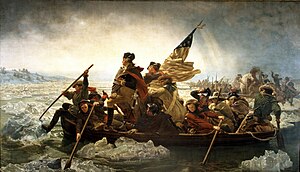This is an old revision of this page, as edited by Red4tribe (talk | contribs) at 23:01, 10 June 2008 (→Battles). The present address (URL) is a permanent link to this revision, which may differ significantly from the current revision.
Revision as of 23:01, 10 June 2008 by Red4tribe (talk | contribs) (→Battles)(diff) ← Previous revision | Latest revision (diff) | Newer revision → (diff)| This article needs additional citations for verification. Please help improve this article by adding citations to reliable sources. Unsourced material may be challenged and removed. Find sources: "Military career of George Washington" – news · newspapers · books · scholar · JSTOR (September 2007) (Learn how and when to remove this message) |
| George Washington | |
|---|---|
 The earliest authenticated portrait of The earliest authenticated portrait ofGeorge Washington shows him wearing his colonel's uniform of the Virginia Regiment from the French and Indian War. | |
| Rank | General of the Armies of the United States |
The military career of George Washington spans over forty years of service to include a promotion over one hundred and seventy five years after his death. Washington's service can be broken in two periods (French and Indian War and the American Revolution) with service in three different armed forces (British Army, Continental Army, United States Army).
22 February 1732: George Washington is born in Westmoreland County, Virginia.
First Term of Service
1752: Appointed to the rank of Major in the British Army with a Colonial Commission and becomes District Adjutant General of the Virginia Militia (21 years old).
1753: Carries a British ultimatum to the French on the Ohio frontier to withdraw from the disputed area (22 years old).
1754: Commissioned a Lieutenant Colonel in the Colonial Militia and is defeated by the French during an attack at Fort Duquesne. (23 years old)
1755: Actively attempts to receive a regular commission in the British Army. When his request is refused, becomes aide to General Edward Braddock with a commission as a Lieutenant Colonel in the Provincial Forces. Takes command of Braddock’s force after the ill-fated Monongahela expedition. For his bravery, is promoted to Colonel and becomes Commander of the Virginia Forces (24 years old).
1758: After three years of various tours in the French and Indian War, is appointed an Acting Brigadier General and leads Virginia forces in the Forbes expedition that resulted in the French evacuation of Fort Duquesne and the British founding of Pittsburgh. Later that year is elected to the Virginia House of Burgesses and effectively retires from active duty, reverting to his permanent title of Colonel in the Virginia Militia (26 years old).
Second Term of Service

1774: After sixteen years of inactivity with the military, becomes a Virginia delegate to the First Continental Congress. Is the only delegate to wear a military uniform and requests that he be addressed as “Colonel Washington” by other members of the Congress (42 years old).
June 1775: Is elected by the Second Continental Congress to serve as “General and Commander-in-Chief” of the Continental Army. A month later, Washington assumes command of the Continental Army at Cambridge, Massachusetts (43 years old).
15 June 1775 - 23 December 1783: Commanding American General during the Revolutionary War with actions at Boston (March 1776), Trenton, New Jersey (December 1776), Princeton, New Jersey (January 1777), Brandywine (September 1777), Germantown (October 1777), Monmouth (June 1778), and Yorktown (October 1781).
December 1783: Resigned as Commander-in-Chief of the Continental Army shortly after discouraging a group of Army officers from seizing control of the fledging American government to establish a military dictatorship. Washington thereafter resumes the life of a gentleman farmer at Mount Vernon (51 years old).
1798: A year after leaving office as the first President of the United States (1789-1797), Washington is recalled to active duty by President John Adams. As the rank structure of the new United States Army had stabilized by this point, Washington’s three stars as a Continental Army General are converted to the rank of Lieutenant General in the United States Army. Washington’s recall orders state that he is to be “Commander in chief of all armies raised or to be raised for service in a prospective war with France” (see: Quasi War) (66 years old).
14 December 1799: George Washington dies at the age of 67. Upon his passing he is listed as a retired Lieutenant General on the rolls of the United States Army. Over the next one hundred and seventy seven years, Washington eventually becomes junior to later Generals and Generals of the Army who serve in the major wars of the 20th century.
General of the Armies
19 January 1976: Posthumously promoted to the grade of General of the Armies of the United States by congressional joint resolution which also stated that this grade has rank and precedence over all other grades of the Army, past or present.
Battles
During his military career, he fought in many battles, mostly in the American Revolution.
Victories
- Boston(1775)
- Harlem(1776)
- Trenton(1776)
- Princeton(1777)
- Battle of the Assunpink Creek(1777)
- White Marsh(1777)
- Monmouth(1778)
- Yorktown(1781)
Defeats
- Great Meadows(1754)
- New York(1776)
- White Plains(1776)
- Fort Washington(1776)
- Assunpink Creek(1776)
- Brandywine(1777)
- Germantown(1777)
Rank History
- Major: 1752
- Lieutenant Colonel: 1754
- Colonel: 1755
- Brigadier General (Acting): 1758
- General and Commander-in-Chief: June 1775
- Lieutenant General, United States Army: 1798
- General of the Armies of the United States: 1976
Source
- Commanding Generals and Chiefs of Staff (Center for Military History)